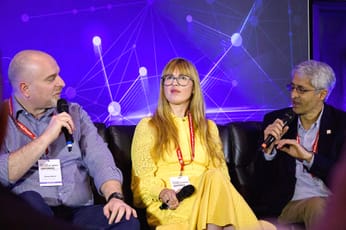#newsrw - multiplatform strategies
Ron Diorio, VP of business development & innovation director, Economist Media Group
 What is a platform? asked Ron, rattling through a list of OSes, apps and social networks, to a mixed response from the audience – there was no clear agreement as to what a platform is. The Economist Media Group publishes both text and date, and he works on both. The scope of their publishing through pretty much every device you can think of is challenging. They’ve just started working with SoundCloud to figure out how to socialise their audio content.
What is a platform? asked Ron, rattling through a list of OSes, apps and social networks, to a mixed response from the audience – there was no clear agreement as to what a platform is. The Economist Media Group publishes both text and date, and he works on both. The scope of their publishing through pretty much every device you can think of is challenging. They’ve just started working with SoundCloud to figure out how to socialise their audio content.
How can they take the data they have in the magazine and the organisation to create apps? My MBA allowed potential students to set their own preferences for ranking criteria. They’re about to launch an iPad app called The World in Figures. A book to an app? They actually extract the data from the file they get back from the printer…
They’re aiming to have continuity of experience across the different platforms. And they need rational pricing structures.
The World in 2012 was a straight conversion of the annual supplement. In June they started working with the editorial team to build a highlights app, and drive sales of the paper magazine. Intelligent Life. Great experience. His kids were really, really excited about him working on apps. His daughter read him reviews over the breakfast table… Electionism is an application they’re building with multiple partners, allowing them to bring both their content and aggregation together in one place. It’s an experiment in tablet publishing.
Lucia Adams, digital development editor. The Times
 In the summer of 2009, all the digital journalists were called together, and told that a group of them were being sent into a bunker to work on the new version of the site. Not only were they implementing a paywall, but they would be a launch partner for the iPad in the UK… The engines of Wapping were in overdrive. They were doing two major things without precedent.
In the summer of 2009, all the digital journalists were called together, and told that a group of them were being sent into a bunker to work on the new version of the site. Not only were they implementing a paywall, but they would be a launch partner for the iPad in the UK… The engines of Wapping were in overdrive. They were doing two major things without precedent.
We knew that the iPad would have loads of exciting features – you could shake it to make it do things. Every time they ran up to James Harding with new features, they cam back simpler and simpler. It came to resemble the newspaper. It was the same at 9pm as it was at 6am. And some readers enjoy the linear experience that brings. No decisions to make… Like the newspaper it’s put together by a dedicated team, who hand craft it. And the beginning the development was very fast. The experts in the team could see that a photo needed to be 5 pixels wider.
The iPads they were working with as they developed it were bolted to the desk. It was still a secret device. They were buildings things on an untried platform, with no existing support tools. And it’s stayed in the top 10 grossing apps list.
They’ve had problems with the Kindle edition. They had to get the R&D lab to spend two weeks on it. It’s out there – so you have to get it fixed. And they’ve not been able to find a way to get the Kindle edition into the general subs package.
They now have The Times in seven different formats. They’re allowing the readers to choose – they’re not dictating where people read particular things.
Douglas Arellanes, Sourcefabric
 They’re trying to Open Source news… They’re an NGO, trying to lower the barriers to entry so that smaller organisations can punch above their weight in news. And it’s to do with the least sexy bits of getting news online – the back end, the plumbing. Workflow needs to be built around content and not the other way around. In existing workflows, the technology determines the content. They try to reverse that, making it more natural for the journalists.
They’re trying to Open Source news… They’re an NGO, trying to lower the barriers to entry so that smaller organisations can punch above their weight in news. And it’s to do with the least sexy bits of getting news online – the back end, the plumbing. Workflow needs to be built around content and not the other way around. In existing workflows, the technology determines the content. They try to reverse that, making it more natural for the journalists.
There are so many new platforms emerging that you need to be ready for anything. Make your system modular, tie them together with APIs, and make those APIs as rational as possible. When Basler Zeitung – a Swiss newspaper – was taken over by a right wing politician, the editorial team walked to set up by themselves as Tages Woche. Sourcefabric built Superdesk to bring the workflows together and manage print and web output from one CMS.
Ingest: Wires, data, APIS –> Process: create one, publish everywhere –> Output: every channel
Open source means free software (but someone from the audience disagrees). But more than that, you’re free to tinker with it and modify it to your purposes. You create a community of interest around the software. They may be half way around the world, but they’re dealing with the same issues as you. You can share this effort.
They are about to launch a new product called
Mike Goldsmith, editor in chief of iPad and tablet editions, Future
 Should you be on iPad/Kindle/Nook? Yes. What should you do…? Ah. Interesting question.
Should you be on iPad/Kindle/Nook? Yes. What should you do…? Ah. Interesting question.
Newsstands are good things for publishers. Rectangles made of glass are a lot like rectangles made of paper.
Future’s publishing? Interactive editions: T3 (Woodwing), Guitarist Deluxe (Adobe DPS) and Tap! (their own platform). Digital replicas: 65 titles.
- Digital replicas – make sense on tablets. Procycling looks fantastic on glass, because of its photography. And they’re multi-platform. They’re scaleable, affordable (team of 6 for all 65) and quick flag in the ground. BUT they’re seen as a poor relation, they”re not completely automated, and you can’t upsell advertising.
- Interactive Editions – Perfect for iOS. (People aren’t buying on Android) Performs well for conversion, developer friendly, and clients like it. And more chance of Apple promotion. BUT you can’t necessarily sell them for more. And extra devices are extra work. The business models have not yet settled – they’re experimenting and the manuals have yet to be written. HD Edition has to have HD content. There aren’t any good design companies producing HTML 5 ads yet – you end up doing it. You’re figuring out this as you go. Interactive editions: sexy, expensive, the future – and in need of thought if it’s going to be multi-device.
So… which is best? Digital replicas allow you to learn. Then you can (if the demand is there) upscale to an interactive edition and start to innovate.
There are new readers for you out there…
Sign up for e-mail updates
Join the newsletter to receive the latest posts in your inbox.










